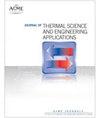Thermal Inactivation of Airborne SARS-CoV-2 by an Electric Fan Heater in Winter and Defining Conditions to Ensure That All the Air Passes through the Fan
IF 1.4
4区 工程技术
Q3 ENGINEERING, MECHANICAL
引用次数: 0
Abstract
Abstract The way the severe acute respiratory syndrome coronavirus 2 (SARS-CoV-2) is spread, especially in closed environments, is airborne transmission. The study aims to assess the thermal inactivation of airborne SARS-CoV-2 in a 30 m3 test room as a function of outlet temperature, airflow rate, and operating time of an electric heater, then define a condition to ensure that all air in the room passes through the electric heater. Aerosolized SARS-CoV-2 was delivered to the test room at an ambient temperature of 20 C and 40% humidity. Two electric heaters with different power and airflow rates were operated respectively in the test room to compare their efficiencies in the inactivation of airborne SARS-CoV-2. The first and second electric heaters had power, airflow rates, and outlet temperatures of 1.5 kW, 44 m3/h, 220 °C, and 3 kW, 324 m3/h, and 150 °C, respectively. A fan drew the outside air into the heater. In the first experiment, a 1.5 kW electric heater was operated in the test room for 80 minutes. In the second experiment, a 3 kW electric heater was used in the test room for 75 minutes. Airborne SARS-CoV-2 in the test room was inactivated by 99.00% and 99.96% in the first and second experiments, respectively. A condition is defined to ensure that all the air in the room passes at least once through the electric heater fan.电风扇加热器在冬季机载SARS-CoV-2的热灭活及确保所有空气通过风扇的条件
严重急性呼吸综合征冠状病毒2 (SARS-CoV-2)的传播方式主要是空气传播,特别是在封闭环境中传播。本研究旨在评估在一个30 m3的测试室内,空气中SARS-CoV-2的热失活与出口温度、流速和电加热器运行时间的关系,并确定一个条件,以确保房间内的所有空气都通过电加热器。雾化后的SARS-CoV-2在环境温度为20℃、湿度为40%的条件下被送到试验室。在试验室中分别运行两台不同功率和风量的电加热器,比较它们对空气中SARS-CoV-2的灭活效率。第一和第二电加热器的功率、气流速率和出口温度分别为1.5 kW、44 m3/h、220°C和3 kW、324 m3/h、150°C。风扇把外面的空气吸入加热器。在第一个实验中,一台1.5 kW的电加热器在试验室运行80分钟。在第二个实验中,在测试室内使用3kw电加热器75分钟。第一次和第二次实验中,试验室空气传播的SARS-CoV-2灭活率分别为99.00%和99.96%。设定条件,保证室内所有空气至少一次通过电加热风扇。
本文章由计算机程序翻译,如有差异,请以英文原文为准。
求助全文
约1分钟内获得全文
求助全文
来源期刊

Journal of Thermal Science and Engineering Applications
THERMODYNAMICSENGINEERING, MECHANICAL -ENGINEERING, MECHANICAL
CiteScore
3.60
自引率
9.50%
发文量
120
期刊介绍:
Applications in: Aerospace systems; Gas turbines; Biotechnology; Defense systems; Electronic and photonic equipment; Energy systems; Manufacturing; Refrigeration and air conditioning; Homeland security systems; Micro- and nanoscale devices; Petrochemical processing; Medical systems; Energy efficiency; Sustainability; Solar systems; Combustion systems
 求助内容:
求助内容: 应助结果提醒方式:
应助结果提醒方式:


